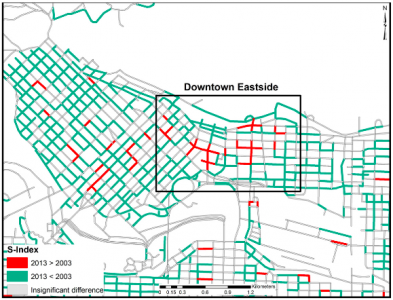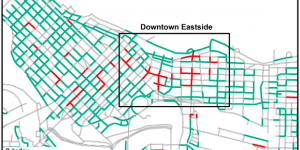In recent years, crime has been on the decline in Canada. The rate of auto theft in Canada dropped by more than 67% since 2003 (Hodgkinson et al., 2016). However, there are areas that have more crime occurrences than others depending on several factors including the type of crime. Hodgkinson et al. aims to investigate the changes in the spatial patterns of auto theft in Vancouver, British Columbia between the years 2003 to 2013. Car theft data has been used for research because it is considered to be reliable as they are more likely to be reported (with reporting rates of ~95%) compared to other crimes (Hodgkinson et al., 2016). More specifically, Hodgkinson and his team wanted to determine what areas are declining and why they are declining to understand what strategies are effective for reducing crime levels in certain areas. The researchers first looked into some literature reviews to gain a better understanding of the relationships in international crime drop and Canada, the rise and decline in auto thefts, and crime and place. Afterwards, they applied this to their analysis of car thefts in Vancouver.
The results of the two analyses confirm that auto theft in Vancouver is spatially concentrated. The kernel density analysis results demonstrated two hotspots that were located in Yaletown and the West End in 2003. These hotspots also represent the most expensive areas of the city with expensive cars (Hodgkinson et al. 2016). The hotspots shifted to the Downtown Eastside with three relative hotspots emerging in 2013. This area is deemed as Canada’s poorest postal code and a socially disorganized neighbourhood well known for high rates of crime (Hodgkinson et al., 2016). As new and more secure cars are being introduced to the market, the rich areas are usually able to afford these cars as opposed to the Downtown Eastside, hence the shift in auto thefts. However, it is important to note that these hotspots are only relative to its respective year as there is a difference in scale due to the 84% decline in auto theft from 2003 to 2013 (Hodgkinson et al. 2016). The Getis-Ord Gi* analysis results also show a similar pattern of auto theft hotspots in the downtown area with a clear eastward shift. In the context of the crime drop, the hotspot in the Downtown Eastside reflects a slower declining rate of auto thefts in the area compared to other areas. Hodgkinson et al. suggests that this crisis would require a place-based prevention strategy to target high-crime areas.


Learning Significance